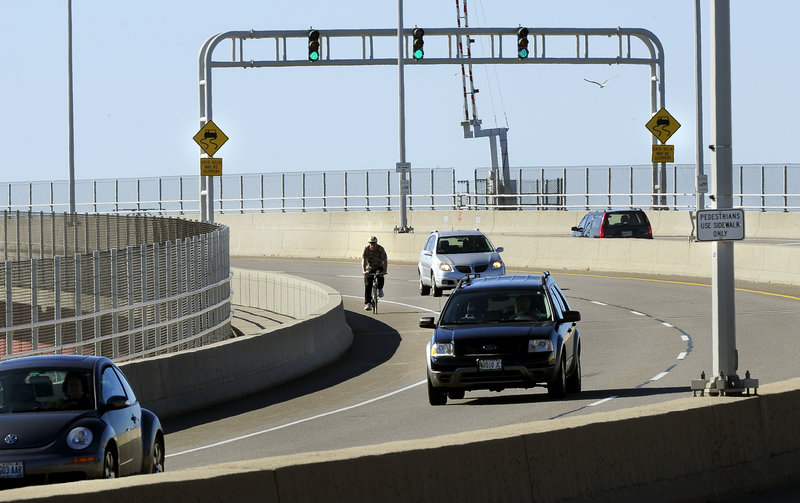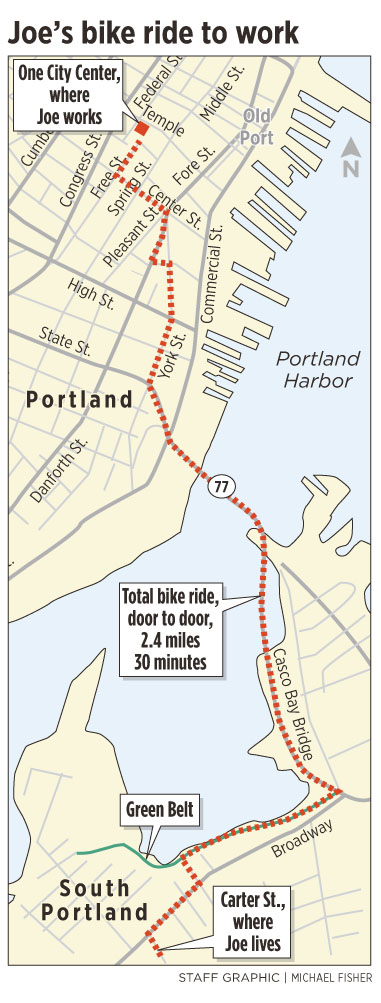Riding a bike while sharing the road with 2-ton vehicles whizzing by delivers tingling, dagger-like sensations to my central nervous system.
I have avoided such situations as much as possible from the day I learned to ride a bike into middle-aged adulthood.
I am not an avid biker, and when I do cycle, I prefer nonmotorized paths. Texting while driving is a menace, and I don’t want to be near texters, especially as a vulnerable cyclist.
So why, then, did I volunteer to write about commuting to work via bicycle?
Good question.
I’m not really sure, but I became curious after reading about the biking-to-work phenomenon and knowing friends and colleagues who cycle to their workplaces. I wanted to join them to see what it’s like. Portland’s compact footprint makes it an attractive city to go car-free, and registered vehicles have declined 23 percent from 2004 to 2011.
While there’s no Portland-based study yet to prove it, people have to get to work somehow, so fewer car owners should mean an increase in bicycle commuting. Not everyone walks or takes the bus.
Bicycle commuters arrive at work energized, emanating a special glow knowing they’re being healthy and benefiting the environment at the same time.
It’s a “twofer” of do-gooding, similar to driving a Toyota Prius while eating organic, locally grown food.
Marching into work clutching a bicycle helmet is a statement, a way to pass judgment on the 99 percent addicted to gas-guzzling, polluting-the-world vehicles. That I would return to the gas-dependent 99 percenters a week later didn’t matter. For a week, I would enjoy righteous superiority.
Prior to my foray into two-pedaled commuting, I kept thinking about the long and winding Casco Bay Bridge, with cars and trucks traveling at 60 mph just a few feet away from my bike. My 2.5-mile route from South Portland required crossing the bridge.
But I found that when I actually crossed the bridge for the first time, I was not enveloped with the same dread that Ichabod Crane felt crossing the bridge at Sleepy Hollow, and I arrived on the other side with my head and body intact. The span provides a wide area for the bicycle path, and the cars were not as close as on city streets.
In between dodging the trash that people threw out of their cars on the bridge, I would gaze across the Fore River and enjoy the view.
Although local officials encourage bicyclists to use the bike lanes that run next to the vehicle lanes on the bridge, bicyclists also are permitted to join walkers on the barrier-protected pedestrian path spanning the bridge, South Portland officials said. I tried the “sidewalk” on the Casco Bay Bridge one time, but I found I worried almost as much about my bike hitting pedestrians on the narrow path behind the barrier as I did about vehicles hitting me on the bridge. So I returned to the bike lane.
The other sections of my route involved taking the Greenbelt Walkway in South Portland, traversing downtown Portland near the waterfront before snaking up to Free Street and parking my bike in the garage near One City Center, where the Press Herald newsroom is located. The Greenbelt was by far the most enjoyable part of the trip, and any tension I felt from avoiding parked cars and navigating through traffic went away as soon as I hit that stretch.
Bicyclists and motorists share the road. But, at times, there’s a reluctant allocation of scarce resources, namely, how wide the bike path is, if there is one. Bicycle-motorist disputes sometimes hit the news, such as on the Martin’s Point Bridge in June, when a cyclist and truck driver argued over how close the driver came to hitting the cyclist. The blow-up went viral on the Internet when the cyclist recorded part of the argument. Fortunately, my easygoing demeanor, staying as far away from vehicles as possible, desire to avoid being recorded saying unflattering things and good luck meant I avoided such confrontations and close calls. No one even honked at me.
Bicycling added 15 minutes to my commute, door-to-door. Driving takes 15 minutes; biking a half hour. I did feel extra refreshed at work, but my week missed 90-degree days.
According to a 2011 Rutgers University study, bike commuters increased by 64 percent from 1990 to 2009. It does make sense to bike, especially if you can get to work within 30 minutes and you don’t have to drive once you arrive at work.
As a news reporter, I do use my car at work. But I could store my vehicle in the work parking garage overnight, so my car would be available in case I had to drive to interviews.
Brian Allenby, 32, communications director of the Bicycle Coalition of Maine, commutes from his home in Cumberland to downtown Portland, taking 40 to 45 minutes on a 14-mile bike route. Driving would take about 30 minutes, Allenby said.
Allenby bicycles even during the winter, which he said is not as crazy as one might think. Allenby said he dresses in thin, insulated layers and he warms up within a few minutes of leaving the house.
While I can’t imagine biking to work during the winter, after my one-week experiment, I had to ask myself: Would I become a bicycle commuter for real?
I think so, but it depends.
I started working in Portland a few months ago, moving from Virginia. My wife and children will be joining me soon, and where our family ends up settling will determine whether I would consider biking to work a few days per week. If we bought a house in Portland, I would strongly consider biking to work at least part of the time, because the city’s bike paths limit the amount of time in traffic. Even though the Casco Bay Bridge wasn’t as scary as I envisioned, I would not want to cross it every day. A texting motorist drifting into the bike lane could kill me on the spot at Casco Bay Bridge speeds.
Allenby said texters and distracted drivers are “terrifying” even to experienced cyclists. He pointed out that new horns for bicycles are being made that sound like a car horn. If you see a car starting to drift into the bike lane, he said, you can “honk” your horn just as loudly as if you were driving a car.
Another safety measure on city streets is relocating the bike lane next to sidewalks, and moving parked vehicles a few feet away from the curb. That gives bicyclists more protection from traffic because the parked vehicles provide a barrier, as well as making it less likely that someone in a parked car will open the door in front of a bicyclist.
“You could still get ‘doored’ from the passenger side, but it’s much more likely to happen on the driver’s side,” Allenby told me.
Allenby said the bike lane next to the sidewalks is a big success in New York City and Washington, D.C., and has encouraged more cycling.
“The only way to get more people riding is if they feel comfortable and safe while riding,” Allenby said.
Portland is looking at expanding the bike-share program and studying whether to extend the Bayside Trail, increasing the footprint of paths sans cars. Both efforts would make it easier to commute via bicycle.
As it was, I did not feel entirely safe on my route, but I enjoyed my week as a bicycle commuter.
And I liked it that for a week, at least, my co-workers might have viewed me as an athletic and healthy person, the kind of guy who picks up organic blueberries at the downtown farmers market before pedaling home.
If they saw me as “insufferable” in addition to “athletic and healthy,” so be it.
I biked to work and they didn’t.
Joe Lawlor can be contacted at 791-6376 or at:
jlawlor@pressherald.com
Twitter: @joelawlorph
Send questions/comments to the editors.





